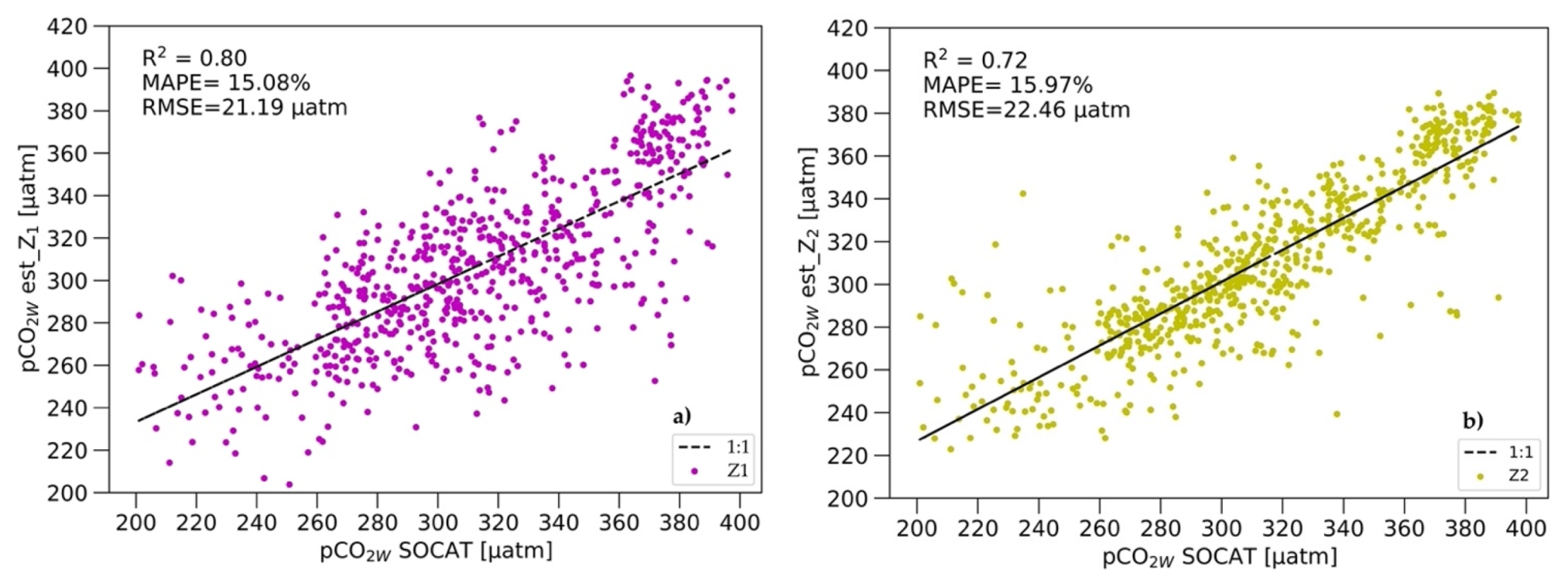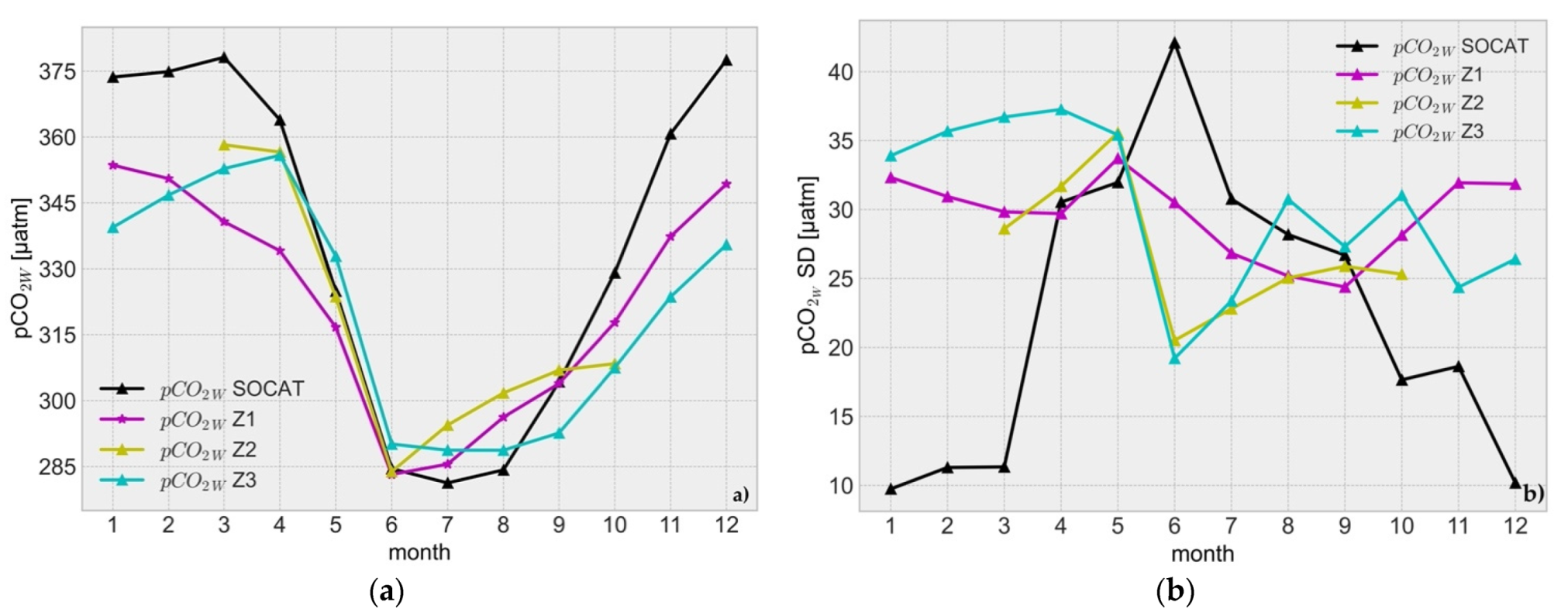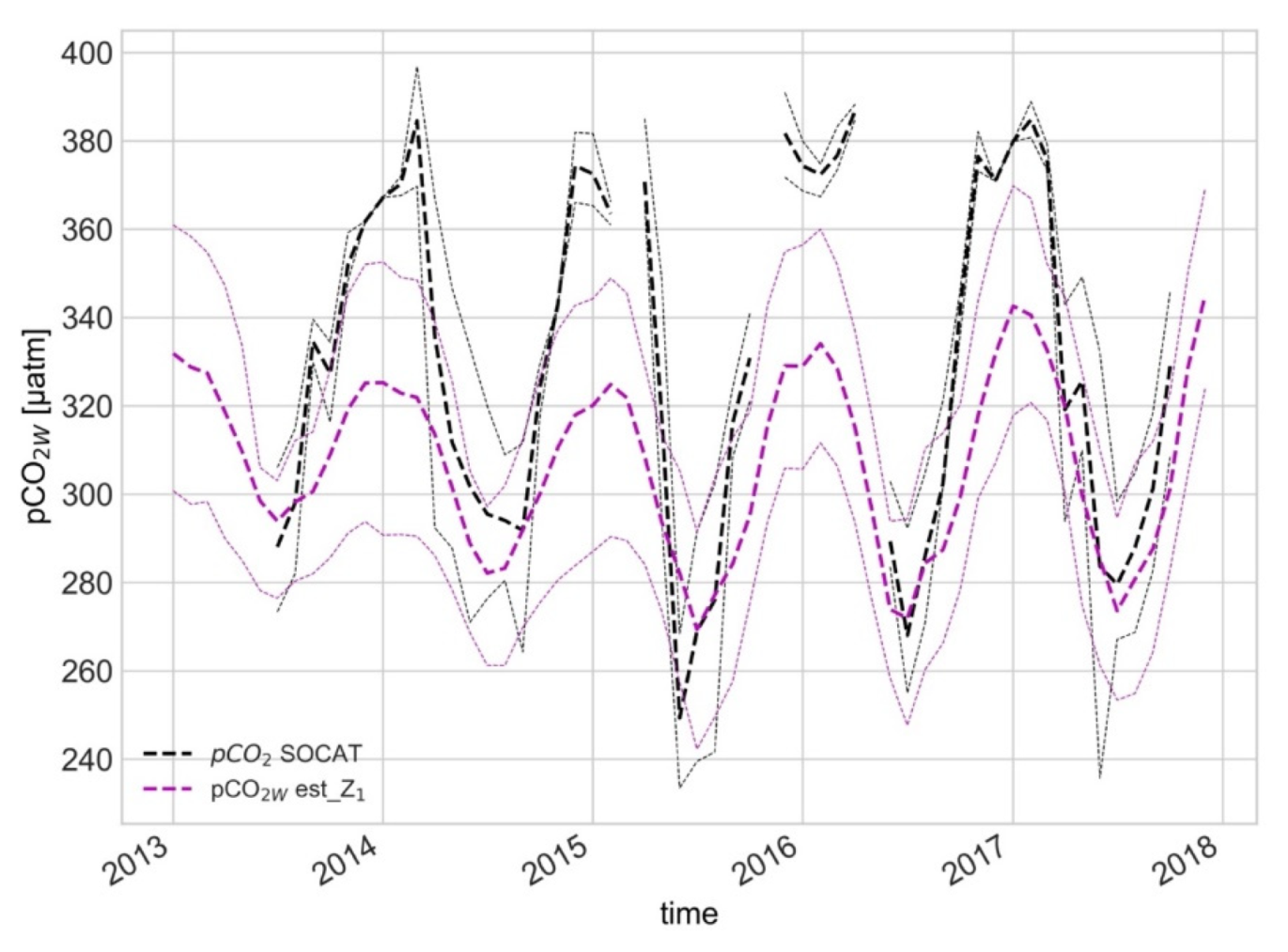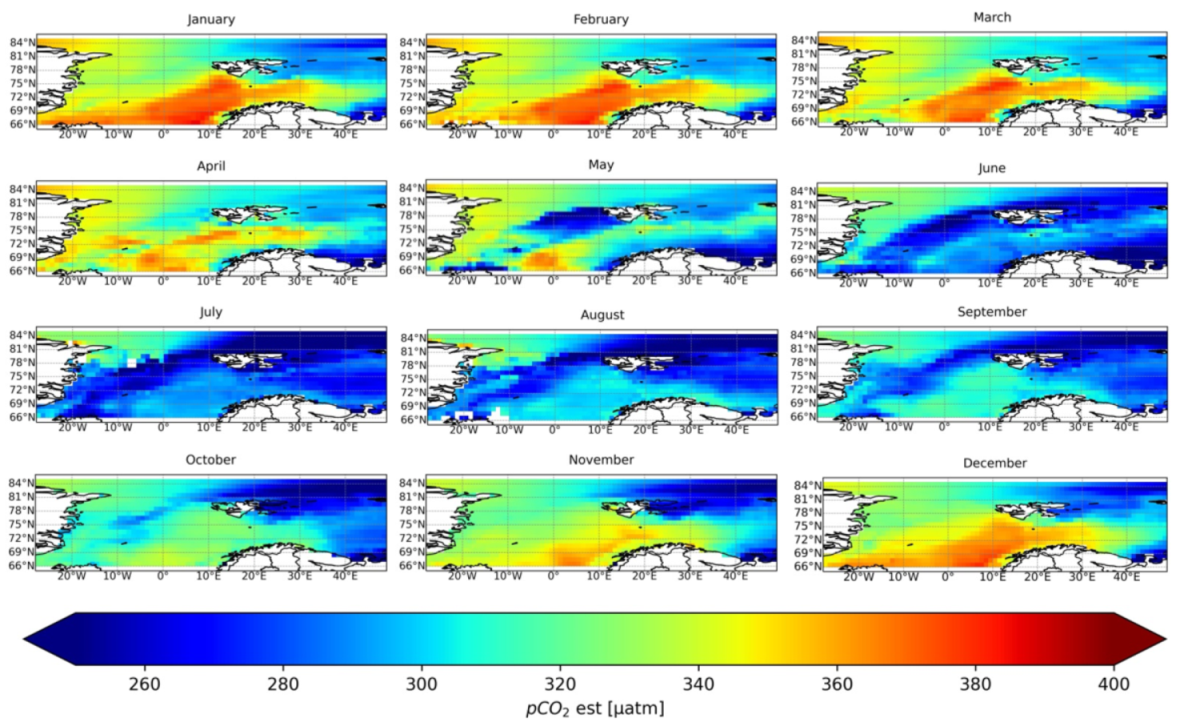The Distribution of pCO2W and Air-Sea CO2 Fluxes Using FFNN at the Continental Shelf Areas of the Arctic Ocean
Abstract
:1. Introduction
2. Materials and Methods
2.1. Data for Estimating pCO2W
2.2. Methods of pCO2W Estimation Using Feed-Forward Neural Network
2.3. Data for Air-Sea CO2 Fluxes
2.4. Calculation of Air-Sea CO2 Fluxes
3. Results
3.1. Estimated pCO2W Values Based on Three Models
3.2. Spatial pCO2W and Air-Sea CO2 Flux Distribution Based on the Z1 Model
4. Discussion
5. Conclusions
Supplementary Materials
Author Contributions
Funding
Institutional Review Board Statement
Informed Consent Statement
Data Availability Statement
Acknowledgments
Conflicts of Interest
References
- Global Monitoring Laboratory, Mauna Loa. Available online: https://gml.noaa.gov/dv/iadv/graph.php?code=MLO&program=ccgg&type=ts (accessed on 14 February 2021).
- Sabine, C.L.; Feely, R.A.; Gruber, N.; Key, R.M.; Lee, K.; Bullister, J.L.; Wanninkhof, R.; Wong, C.S.; Wallace, D.W.R.; Tilbrook, B.; et al. The Oceanic sink for anthropogenic CO2. Science 2004, 305, 367–371. [Google Scholar] [CrossRef] [Green Version]
- Le Quéré, C.L.; Takahashi, T.; Buitenhuls, E.; Rödenbeck, C.; Sutherland, S.C. Impact of climate change and variability on the global oceanic sink of CO2. Global Biogeochem. Cycles 2010, 24. [Google Scholar] [CrossRef] [Green Version]
- Gregor, L.; Kok, S.; Monteiro, P.M.S. Empirical methods for the estimation of Southern Ocean CO2: Support vector and random forest regression. Biogeosciences 2017, 14, 5551–5569. [Google Scholar] [CrossRef] [Green Version]
- Watson, A.J.; Schuster, U.; Shutler, J.D.; Holding, T.; Ashton, I.G.C.; Landschützer, P.; Woolf, D.K.; Goddijn-Murphy, L. Revised estimates of ocean-atmosphere CO2 flux are consistent with ocean carbon inventory. Nat. Commun. 2020, 11, 4422. [Google Scholar] [CrossRef]
- Friedlingstein, P.; Jones, M.W.; O’Sullivan, M.; Andrew, R.M.; Hauck, J.; Peters, G.P.; Peters, W.; Pongratz, J.; Sitch, S.; Le Quéré, C.; et al. Global carbon budget 2019. Earth Syst. Sci. Data 2019, 11, 1783–1838. [Google Scholar] [CrossRef] [Green Version]
- Woolf, D.K.; Shutler, J.D.; Goddijn-Murphy, L.; Watson, A.J.; Chapron, B.; Nightingale, P.D.; Donlon, C.J.; Piskozub, J.; Yelland, M.J.; Ashton, I.; et al. Key uncertainties in the recent air-sea flux of CO2. Glob. Biogeochem. Cycles 2019, 33, 1548–1563. [Google Scholar] [CrossRef] [Green Version]
- Doney, S.C.; Fabry, V.J.; Feely, R.A.; Kleypas, J.A. Ocean Acidification: The other CO2 problem. Ann. Rev. Mar. Sci. 2009, 1, 169–192. [Google Scholar] [CrossRef] [Green Version]
- Wrobel, I.; Piskozub, J. Effect of gas-transfer-velocity parameterizations choice on air-sea CO2 fluxes in the North Atlantic and the European Arctic. Ocean Sci. 2016, 12, 1091–1103. [Google Scholar] [CrossRef] [Green Version]
- Cooper, D.J.; Watson, A.J.; Ling, R.D. Variation of pCO2 along a North Atlantic shipping route (U.K. to the Caribbean): A year of automated observations. Mar. Chem. 1998, 60, 147–164. [Google Scholar] [CrossRef]
- Bates, N.R.; Mathis, J.T. The Arctic Ocean marine carbon cycle: Evaluation of air-sea CO2 exchanges, ocean acidification impacts and potential feedbacks. Biogeosciences 2009, 6, 2433–2459. [Google Scholar] [CrossRef] [Green Version]
- Bates, N.R.; Michaels, A.F.; Knap, A.H. Seasonal and interannual variability of oceanic carbon dioxide species at the U.S. JGOFS Bermuda Atlantic Time-Series Study (BATS) site. Deep-Sea Res. II 1996, 43, 347–383. [Google Scholar] [CrossRef]
- Lefèvre, N.; Watson, A.J.; Watson, A.R. A comparison of multiple regression and neural network techniques for mapping in situ pCO2 data. Tellus B 2005, 57, 375–384. [Google Scholar] [CrossRef]
- Cai, W.-J.; Dai, M.; Wang, Y. Air-sea exchange of carbon dioxide in ocean margins: A province-based synthesis. Geophys. Res. Lett. 2006, 33, L12603. [Google Scholar] [CrossRef] [Green Version]
- Telszewski, M.; Chazottes, A.; Schuster, U.; Watson, A.J.; Moulin, C.; Bakker, D.C.E.; González-Dávila, M.; Johannessen, T.; Körtzinger, A.; Lüger, H.; et al. Estimating the monthly pCO2 distribution in the North Atlantic using a self-organizing neural network. Biogeosciences 2009, 6, 1405–1421. [Google Scholar] [CrossRef] [Green Version]
- Landschützer, P.; Gruber, N.; Bakker, D.C.E.; Schuster, U.; Nakaoka, S.; Payne, M.R.; Sasse, T.; Zeng, J. A neural network-based estimate of the seasonal to inter-annual variability of the Atlantic Ocean carbon sink. Biogeosciences 2013, 10, 7793–7815. [Google Scholar] [CrossRef] [Green Version]
- Takahashi, T.; Sutherland, S.C.; Wanninkhof, R.; Sweeney, C.; Feely, R.A.; Chipman, D.W.; Hales, B.; Friederich, G.; Chavez, F.; Sabine, C.; et al. Climatological mean and decadal change in surface ocean pCO2 and net sea-air CO2 flux over the global oceans. Deep-Sea Res. Pt. II 2009, 56, 554–577. [Google Scholar] [CrossRef]
- Friedrich, T.; Oschlies, A. Neural network-based estimates of North Atlantic surface pCO2 from satellite data: A methodological study. J. Geophys. Res. 2009, 114, C03020. [Google Scholar] [CrossRef] [Green Version]
- Nakaoko, S.; Telszewski, M.; Nojiri, Y.; Yasunaka, S.; Miyazaki, C.; Mukai, H.; Usui, N. Estimating temporal and spatial variation of ocean surface pCO2 in the North Pacific using a self-organizing map neural network technique. Biogeosciences 2012, 10, 6093–6106. [Google Scholar] [CrossRef] [Green Version]
- Yasunaka, S.; Murata, A.; Watanabe, E.; Chierici, M.; Fransson, A.; van Heuven, A.; Hoppema, M.; Ishii, M.; Johannessen, T.; Kosugi, N.; et al. Mapping of the air-sea CO2 flux in the Arctic Ocean and its adjacent seas: Basin-wide distribution and seasonal to interannual variability. Polar Sci. 2016, 10, 323–334. [Google Scholar] [CrossRef]
- Yasunaka, S.; Siswanto, E.; Olsen, A.; Hoppema, M.; Watanabe, E.; Fransson, A.; Chierici, M.; Murata, A.; Lauvset, S.K.; Wanninkhof, R.; et al. Arctic Ocean CO2 uptake: An improved multiyear estimate of the air-sea CO2 flux incorporating chlorophyll-a concentrations. Biogeosciences 2018, 15, 1643–1661. [Google Scholar] [CrossRef] [Green Version]
- Laruelle, G.G.; Landschützer, P.; Gruber, N.; Tison, J.-L.; Delille, B.; Regnier, P. Global high-resolution monthly pCO2 climatology for the coastal ocean derived from neural network interpolation. Biogeosciences 2017, 14, 4545–4561. [Google Scholar] [CrossRef] [Green Version]
- Denvil-Sommer, A.; Gehlen, M.; Vrac, M.; Mejia, C. LSCE-FFNN-v1: A two-step neural network model for the reconstruction of surface ocean pCO2 over the global ocean. Geosci. Model Dev. 2019, 12, 2091–2105. [Google Scholar] [CrossRef] [Green Version]
- Longhurst, A.; Sathyendranath, S.; Platt, T.; Cavarhill, C. An estimate of global primary production in the ocean from satellite radiometer data. J. Plankton Res. 1995, 17, 1245–1271. [Google Scholar] [CrossRef] [Green Version]
- Wrobel, I. Monthly dynamics of carbon dioxide exchange across the sea surface of the Arctic Ocean in response to changes in gas transfer velocity and partial pressure of CO2 in 2010. Oceanologia 2017, 59, 445–459. [Google Scholar] [CrossRef]
- Chierici, M.; Olse, A.; Johannessen, T.; Trinañes, J.; Wanninkhof, R. Algorithms to estimate the carbon dioxide uptake in the northern North Atlantic using shipboard observations, satellite and ocean analysis data. Deep-Sea Res. Pt. II 2009, 56, 630–639. [Google Scholar] [CrossRef]
- Bakker, D.C.E.; Pfeil, B.; Landa, C.S.; Metzl, N.; O’Brien, K.M.; Olsen, A.; Smith, K.; Cosca, C.; Harasawa, S.; Jones, S.D.; et al. Multi-decade record of high-quality fCO2 data in version 3 of the Surface Ocean CO2 Atlas (SOCAT). Earth Syst. Sci. Data 2016, 8, 383–413. [Google Scholar] [CrossRef] [Green Version]
- Körtzinger, A. Determination of carbon dioxide partial pressure (pCO2). In Methods of Seawater Analysis, 3rd ed.; Grasshoff, K., Kremling, K., Ehrhardt, M., Eds.; Wiley: Weinheim, Germany, 1999. [Google Scholar] [CrossRef]
- Copernicus Marine Environment Services. Available online: https://resources.marine.copernicus.eu/?option=com_csw&view=details&product_id=GLOBAL_R153 EANALYSIS_PHY_001_026 (accessed on 10 February 2020).
- Forget, G.; Campin, J.M.; Heimbach, P.; Hill, C.N.; Ponte, R.M.; Wunsch, C. ECCO version 4: AN integrated framework for non-linear inverse modelling and global ocean state estimation. Geoscientific Model Dev. 2015, 8, 3071–3104. Available online: https://ecco-group.org/products.htm (accessed on 10 February 2020). [CrossRef] [Green Version]
- Copernicus Marine Environment Services. Available online: https://resources.marine.copernicus.eu/?option=com_csw&view=details&product_id=GLOBAL_R172 EANALYSIS_BIO_001_029 (accessed on 10 February 2020).
- Copernicus Marine Environment Services, NEMO Modeling Platform. Available online: https://resources.marine.copernicus.eu/documents/QUID/CMEMS-GLO-QUID-001-029.pdf (accessed on 10 February 2020).
- European Space Agency/GlobColour Program. Available online: https://hermes.acri.fr (accessed on 10 February 2020).
- Maritorena, S.; Siegel, D.A. Consistent merging of satellite ocean colour data sets using a bio-optical model. Remote Sens. Environ. 2005, 94, 429–440. [Google Scholar] [CrossRef]
- Kohonen, T. Self-organized formation of topologically correct feature maps. Biol. Cybern. 1982, 43, 59–69. [Google Scholar] [CrossRef]
- Keras. Available online: https://keras.io (accessed on 15 November 2021).
- Jamet, C.; Moulin, C.; Lefèvre, N. Estimation of oceanic pCO2 in the North Atlantic from VOS lines in-situ measurements: Parameters need to generate seasonally mean maps. Ann. Geophys. 2007, 25, 2247–2257. [Google Scholar] [CrossRef] [Green Version]
- Dlugokencky, E.J.; Mund, J.W.; Crotwell, A.M.; Crotwell, M.J.; Thoning, K.W. Atmospheric Carbon Dioxide Air Mole Fractions from the NOAA GML Carbon Cycle Cooperative Global Air Sampling Network, 2021, pp. 1968–2020. Available online: https://gml.noaa.gov/aftp/data/trace_gases/co2/flask/surface/README_surface_flask_co2.html (accessed on 30 July 2021).
- Goddijn-Murphy, L.; Woolf, D.K.; Callaghan, A.H.; Nightingale, P.D.; Shutler, J.D. A reconciliation of empirical and mechanistic models of the air-sea gas transfer velocity. J. Geophys. Res. 2016, 121, 818–835. [Google Scholar] [CrossRef] [Green Version]
- Weiss, R.F. Carbon dioxide in water and seawater: The solubility of a non-ideal gas. Mar. Chem. 1974, 2, 203–215. [Google Scholar] [CrossRef]
- Weiss, R.F.; Price, B.A. Nitrous oxide solubility in water and seawater. Mar. Chem. 1980, 8, 347–359. [Google Scholar] [CrossRef]
- Nightingale, P.D.; Malin, G.; Law, C.S.; Watson, A.J.; Liss, P.S.; Liddicoat, M.I.; Boutin, J.; Upstill-Goddard, R.C. In situ evaluation of air-sea gas exchange parameterizations using novel conservative and volatile tracers. Glob. Biogeochem. Cycles 2000, 14, 373–387. [Google Scholar] [CrossRef]
- Wanninkhof, R. Relationship between wind speed and gas exchange over the ocean. J. Geophys. Res. 1992, 97C5, 7373–7382. [Google Scholar] [CrossRef]
- Ho, D.T.; Law, C.S.; Smith, M.J.; Schlosser, P.; Harvey, M.; Hill, P. Measurements of air-sea gas exchange at high wind speeds in the Southern Ocean: Implications for global parameterizations. Geophys. Res. Lett. 2006, 33, 16611. [Google Scholar] [CrossRef] [Green Version]
- Wanninkhof, R.; McGillis, W.R. Relationship between wind speed and gas exchange over the ocean revisited. Limnol. Oceanogr. Meth. 2014, 12, 351–362. [Google Scholar] [CrossRef]
- Wanninkhof, R.; McGillis, W.R. A cubic relationship between air-sea CO2 exchange and wind speed. Geophys. Res. Lett. 1999, 26, 1889–1892. [Google Scholar] [CrossRef]
- McGillis, W.R.; Edson, J.B.; Hare, J.R.; Fairall, C.W. Direct covariance air-sea CO2 fluxes. J. Geophys. Res. 2001, 106, 16729–16745. [Google Scholar] [CrossRef]
- Couldrey, M.P.; Oliver, K.I.C.; Yool, A.; Halloran, P.R.; Achterberg, E.R. On which timescale do gas transfer velocities control North Atlantic CO2 flux variability? Global Biogeochem. Cyc. 2016, 30, 787–802. [Google Scholar] [CrossRef] [Green Version]
- Arrigo, K.R.; van Dijken, G.; Pabi, S. Impact of shrinking Arctic ice cover on marine primary production. Geophys. Res. Lett. 2008, 35, LI9603. [Google Scholar] [CrossRef]
- Arrigo, K.R.; Pabi, S.; van Dijken, G.L.; Maslowski, W. Air-sea flux of CO2 in the Arctic Ocean, 1998–2003. J. Geophys. Res. 2010, 115, G04024. [Google Scholar] [CrossRef]
- Arrigo, K.R.; Perovich, D.K.; Pickart, R.S.; Brown, Z.W.; van Dijken, G.L.; Lowry, K.E.; Mills, M.M.; Palmer, M.A.; Balch, W.M.; Bahr, F.; et al. Massive phytoplankton blooms under Arctic sea ice. Science 2012, 336, 1408. [Google Scholar] [CrossRef] [PubMed] [Green Version]
- Chen, M.; Kim, J.-H.; Nam, S.-I.; Niessen, F.; Hong, W.-L.; Kand, M.-H.; Hur, J. Production of fluorescent dissolved organic matter in Arctic Ocean sediments. Sci. Rep. 2016, 6, 39213. [Google Scholar] [CrossRef] [PubMed] [Green Version]
- Lønborg, C.; Carreira, C.; Jickells, T.; Álvarez-Salgado, X.-A. Impacts of global change on ocean dissolved organic carbon (DOC) Cycling. Front. Mar. Sci. 2020, 7, 466. [Google Scholar] [CrossRef]
- Olsen, A.; Brown, K.R.; Chierici, M.; Johannessen, T.; Neill, C. The sea surface CO2 fugacity and its relationship with environmental parameters in the subpolar North Atlantic 2005. Biogeosci. Disc. 2007, 4, 1737–1777. [Google Scholar]







| SST | SSS | MLD | Chl-aY | Chl-aS | |
|---|---|---|---|---|---|
| Min | −1.9 | 30 | 5.7 | 0.01 | 0.05 |
| Max | 14 | 35 | 3536 | 3.2 | 14.9 |
| σ | 3.8 | 1.2 | 154 | 0.4 | 1.2 |
| Count | 73,421 | 73,421 | 76,740 | 80,100 | 28,686 |
| Model | Elements n | Target | No. of Data |
|---|---|---|---|
| Z1 | log(Chl-aY), log(MLD), SST, SSS, lat, lon, time | SOCAT pCO2W | 2720 |
| Z2 | log(Chl-aS), log(MLD), SST, SSS, lat, lon, time | SOCAT pCO2W | 1943 |
| Z3 | log(MLD), SST, SSS, lat, lon, time | SOCAT pCO2W | 2720 |
Publisher’s Note: MDPI stays neutral with regard to jurisdictional claims in published maps and institutional affiliations. |
© 2022 by the authors. Licensee MDPI, Basel, Switzerland. This article is an open access article distributed under the terms and conditions of the Creative Commons Attribution (CC BY) license (https://creativecommons.org/licenses/by/4.0/).
Share and Cite
Wrobel-Niedzwiecka, I.; Kitowska, M.; Makuch, P.; Markuszewski, P. The Distribution of pCO2W and Air-Sea CO2 Fluxes Using FFNN at the Continental Shelf Areas of the Arctic Ocean. Remote Sens. 2022, 14, 312. https://doi.org/10.3390/rs14020312
Wrobel-Niedzwiecka I, Kitowska M, Makuch P, Markuszewski P. The Distribution of pCO2W and Air-Sea CO2 Fluxes Using FFNN at the Continental Shelf Areas of the Arctic Ocean. Remote Sensing. 2022; 14(2):312. https://doi.org/10.3390/rs14020312
Chicago/Turabian StyleWrobel-Niedzwiecka, Iwona, Małgorzata Kitowska, Przemyslaw Makuch, and Piotr Markuszewski. 2022. "The Distribution of pCO2W and Air-Sea CO2 Fluxes Using FFNN at the Continental Shelf Areas of the Arctic Ocean" Remote Sensing 14, no. 2: 312. https://doi.org/10.3390/rs14020312






